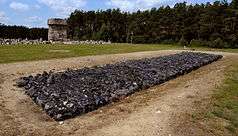Chil Rajchman
| Chil Rajchman | |
|---|---|
.jpg) Chil Rajchman in Poland | |
| Born |
Henryk Reichman June 14, 1914 Łódź, Poland |
| Died |
c. May 7, 2004 (aged 89) Montevideo |
| Known for | Treblinka survivor, author of Treblinka memoir |
Chil Meyer Rajchman a.k.a. Henryk Reichman nom de guerre Henryk Ruminowski (June 14, 1914 – May 7, 2004) was a Polish-Jewish Holocaust survivor; former prisoner of the Treblinka extermination camp which took the lives of 800,000 Jews during the genocidal Operation Reinhard in World War II. Rajchman belonged to a group of inmates who escaped successfully during the perilous Treblinka revolt which resulted in the camp's closure in October 1943. His Treblinka memoir titled The Last Jew of Treblinka: A Memoir originally in Yiddish, was published in 2009 for the very first time in German and French, without the English translation, which appeared in 2011 with the Preface by Elie Wiesel seven years after his death at the age of 89.[1]
Life
Rajchman was born on June 14, 1914 in Łódź. He was one of six children raised by his widowed father.[2] After the invasion of Poland by Nazi Germany, he and his sister joined the family in Pruszków, a small town in central Poland. The Jewish ghetto was created there in October 1940, and liquidated in February 1941.[3] All Pruszków Jews were deported to the Warsaw Ghetto. With the work-permit issued by the Judenrat on German orders, Rajchman went to live and work in Ostrów Lubelski. He was rounded up on October 10, 1942 along with other ghetto inmates, loaded onto a Holocaust train, and sent to Treblinka extermination camp. Upon his arrival at the camp the following day, he was separated from his sister Anna, and put to work with the Jewish Sonderkommando. He was ordered to cut the hair of disrobed women before they were gassed, and later also extracted gold teeth from dead victims at the Totenlager and disposed of thousands of their bodies.[1][4]
On August 2, 1943 along with some one hundred other commando prisoners, Rajchman managed to escape from Treblinka during the Jewish uprising. He returned to Warsaw and lived there until 1944 under false "Aryan" identification papers issued by the Polish underground. During this time he joined the Polish Socialist Party and the underground resistance. On January 17, 1945 he was liberated by the advancing Soviets,[2] and 14 days later returned to his hometown of Łódź where most Jews have already been exterminated. He stayed there till late 1946, but soon emigrated to France with his new wife and then relocated to Uruguay.[4]
In 1980, Rajchman (age 66) was contacted in Uruguay by the American embassy and on March 12, 1980 was interviewed by the Office of Special Investigations about the Treblinka guards. He went to the United States to testify against John Demjanjuk who was later extradited to Jerusalem for a war trial in 1987–1988. Rajchman misidentified Demjanjuk, who apparently never served at Treblinka, as the so-called Ivan the Terrible (Treblinka guard). He failed to identify him from the wartime photograph, but did so at trial. Based on his testimony, Demjanjuk was stripped of his U.S. citizenship.[6] Rajchman died in 2004 in Montevideo, Uruguay.
The Last Jew of Treblinka: A Memoir
It was not until 2009 that Rajchman's Treblinka memoir, written in Yiddish while in Warsaw in 1944–1945, was first translated and published in France under the title Je suis le dernier Juif by Les Arènes. It was then translated into German as Ich bin der letzte Jude. Treblinka 1942/43. The original manuscript in Yiddish had been edited and proofread in 1946 by the poet Nachum Bomze (Bumse) – according to Rajchman's testimony during Demjanjuk's trial in Israel – but appeared in print for the very first time only five years after his death.[4]
Documentary
As an old man, Chil (Enrique) Rajchman was featured in the Uruguayan documentary film Despite Treblinka, along with Kalman Taigman and Samuel (Schmuel) Willenberg from Jerusalem. The film was finished in 2002 and presented at the 24th International Film Festival of New Latin American Cinema in Havana, Cuba.[4]
References
- 1 2 Chil Rajchman (February 15, 2011). "The Last Jew of Treblinka: A Memoir". Pegasus (Amazon Product Details). ISBN 1605981397. Retrieved August 30, 2013.
- 1 2 "Chil Meyer Rajchman". United States Holocaust Memorial Museum. Retrieved August 17, 2013.
- ↑ Virtual Shtetl (2013). "Getto w Pruszkowie". Muzeum Historii Żydów Polskich. Retrieved August 31, 2013.
- 1 2 3 4 Stawsky, Gerardo (June 11, 2009). "Despite Treblinka. Protagonists". Teaching the Holocaust to Spanish speakers. ORT Uruguay University's Film Department – via Internet Archive.
- ↑ Diapositive.pl, "Treblinka" Holocaust Museum online. Jewish Identity and Culture in Poland. Retrieved August 11, 2013.
- ↑ Bill Ong Hing (2004). Defining America: Through Immigration Policy. Temple University Press. pp. 223–224. ISBN 1592132332.
